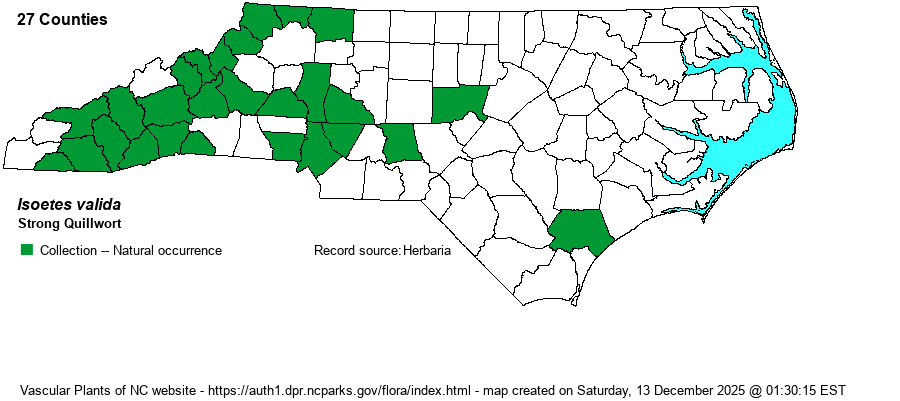| Section 1 » Order Isoetales » Family Isoetaceae |
Show/Hide Synonym
| taxonName | relationship | relatedTaxonName | relatedTaxonRefText | relComments |
|---|
|
|
|
|
| Isoetes valida | = | Isoetes caroliniana | Flora of North America (1993b, 1997, 2000, 2002a, 2002b, 2003a, 2004b, 2005, 2006a, 2006b, 2006c, 2007a, 2009, 2010) | | | Isoetes valida | < | Isoetes engelmannii | Gleason and Cronquist (1991) | | | Isoetes valida | < | Isoetes engelmannii | Radford, Ahles, and Bell (1968) | | | Isoetes valida | < | Isoetes engelmannii | Wofford (1989) | | | Isoetes valida | < | Isoetes engelmannii | Flora of West Virginia | | | Isoetes valida | = | Isoetes engelmannii var. caroliniana | Fernald (1950) | | | Isoetes valida | = | Isoetes engelmannii var. caroliniana | Small (1933, 1938) | | | Source: Weakley's Flora |
|
| Author | (Engelmann) Clute | |
| Distribution | Throughout the Mountains, over most of the western Piedmont, and rarely to the eastern Piedmont. Casual and disjunct (if correctly identified) in the eastern Coastal Plain. The Pender specimen was from a bog near junction of Rocky Point and Castle Hayne-Hampstead Road in 1950, but not cited in Brunton and Britton's 1996 paper, even though they studied specimens at DUKE, NCSC, NCU, and UNCC, among other herbaria.
This is an Appalachian species, ranging from PA south to southern GA and AL. | |
| Abundance | Apparently fairly common in the Mountains, but uncommon to infrequent in the western Piedmont and very rare in the eastern Piedmont. Probably historical now in the Coastal Plain, as the Pender collection was in 1950 (if correctly identified). | |
| Habitat | It grows in "Shallow water near edges of lakes and ponds, seepage wetlands, and small to moderate-sized streams" (Digital Atlas of the Virginia Flora website). It also grows in bogs in NC. | |
| Phenology | Fruits from August to October, the latest of the fruiting quillworts in the region. | |
| Identification | All Isoetes species are quite grass-like, with numerous very slender and grass-like leaves growing from a common base. Most importantly, they are swollen at the base, where the megaspores are present, the key structure for separation of species. The leaves are terete (rounded) and hollow. For identification, see the key in Weakley (2018). | |
| Taxonomic Comments | This species was described by Brunton & Britton (1996), formerly included within I. engelmannii as var. caroliniana.
All Isoetes species are quite grass-like, with numerous very slender and grass-like leaves growing from a common base. Most importantly, they are swollen at the base, where the megaspores are present, the key structure for separation of species. The leaves are terete (rounded) and hollow. For identification, see the key in Weakley (2018). | |
| Other Common Name(s) | Mountain Quillwort, Carolina Quillwort, True Quillwort | |
| State Rank | S3 | |
| Global Rank | G4? | |
| State Status | | |
| US Status | | |
| USACE-agcp | OBL link |
| USACE-emp | OBL link |

